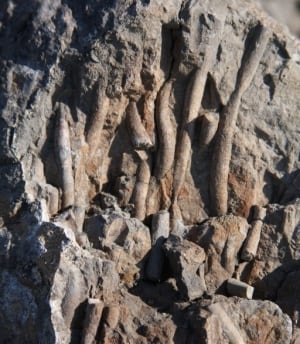Frozen methane hydrates suddenly thawed 110 million years ago during a warming phase
by Jimmy Thomson, CBC News,April 24, 2017

Over 130 mounds like this one were discovered dotting the landscape of Ellef Ringnes Island, 500 kilometres north of Resolute, Nunavut. They point to an ancient release of methane. (submitted by Steve Grasby)
New research suggests a large amount of methane was released in the Arctic Ocean during a period of warming 110 million years ago and the methane "burp" points to the possibility of a similar release in today's warming conditions.
The discovery happened in the remote High Arctic, on Ellef Ringnes Island, about 500 kilometres north of Resolute, Nunavut. During the Cretaceous period, 55 million years before the dinosaurs disappeared, the island was deep underwater.

Fossils like these Cretaceous tubeworms show part of the deep-ocean community that fed off the methane leaking from the mud. (submitted by Steve Grasby )
Suddenly, from under the mud, bubbles of methane began to emerge as frozen deposits began to thaw.
The bubbles left traces in the form of over 130 mounds that persist on the island today, complete with fossils of life that formed around the methane seeps.
"There must have been some brief, rapid release into the ocean," explained Steve Grasby, one of the researchers who visited the island between 2009 and 2011.
"Because we don't see them in the older rocks and we don't see them in the younger rocks. So something must have happened in the Earth's history at that time to release a bunch of methane into the sea," he said.
Evidence of ancient climate change
The thawing of the so-called methane hydrates coincides with a period of warming following a volcanic eruption, which released a cloud of carbon dioxide into the atmosphere.
"That was when Earth transitioned from a cold climate to a warm climate," Grasby said.
"So we see this sudden and short term release of methane is coincident with this period of global climate warming."
- 'It scares me': Permafrost thaw in Canadian Arctic sign of a global trend
- Arctic lakes melting earlier and earlier each year, recent 14-year study shows
Today there are still deposits of methane hydrates buried under the sea. There have been concerns that their thawing could cause runaway climate change, since methane is a powerful, though short-lived, greenhouse gas that could further warm the climate, melting ever more hydrates.
A recent review by the United States Geological Survey says "most" of the methane never reaches the atmosphere.
Grasby says his research points to a period in the Earth's geologic history when warming was releasing the gas from its frozen state, but, like today, it's hard to say what happens next.
No comments:
Post a Comment